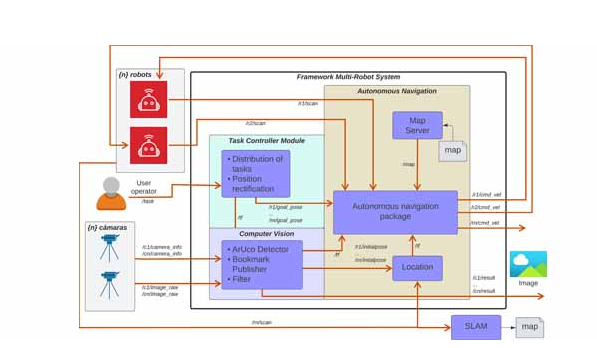Revolution in Shared Intelligence: Researchers Develop Swarm Intelligence Robots
In today's era of rapid advancement in automation technology, collaboration between robots is no longer a science fiction scenario. Imagine this scene: dozens of machines transporting goods in a warehouse without interfering with each other; in a restaurant, robots accurately delivering dishes to designated tables; or in a factory, robot teams dynamically adjusting task distribution based on demand.

(Image source: ieeexplore.ieee.org)
According to foreign media reports, an international research team has developed a new system based on a ROS2-based open-source framework, enabling multiple robots to collaborate in an intelligent, flexible, and safe manner, thereby helping to realize this future vision. The related research results have been published in the journal IEEE Access.
To put theory into practice, researching how robots collaboratively navigate is crucial. The core of robot collaboration lies in their communication capabilities and real-time decision-making mechanisms. This system integrates three key features:
Autonomous Navigation: Each robot uses GPS-like algorithms to calculate the optimal path, but these algorithms have been adaptively optimized for dynamic environments. With tools like GAZEBO, robots can complete training in a virtual environment before being deployed in real-world operations. If unexpected obstacles (such as fallen boxes) are encountered, the system can immediately re-plan the route.
Adaptive behavior: The system uses a dynamic manual of instructions—a "behavior tree." For example, if a robot gets stuck, it will first attempt to turn, then reverse; if the problem remains unsolved, it will request help from the central system. This approach not only prevents collisions but also enables system scalability, expanding from two robots in the laboratory to 20 robots in the factory.
Computer vision and task allocation: Serving as the "eyes" and "brain" of the collaborative system, this technology ensures that robots can accurately locate themselves and execute tasks. The system integrates two technologies: first, ArUco markers (similar to QR codes for robots, which are printed markers used as reference points in the environment); second, distributed cameras. By detecting these markers in real time and performing calculations, the positioning error of each robot can be controlled within 3 centimeters.
The robot seems to carry an internal map that is continuously updated. Another technology is intelligent task allocation, where the system prioritizes assigning the nearest available robot, much like a delivery person choosing the shortest route. When one robot malfunctions, another automatically takes over, ensuring that the task does not stop.
To validate the system, researchers designed complex scenario simulations. In an industrial warehouse scenario, robots need to transport packages between stations marked with ArUco tags while avoiding congestion. In a restaurant scenario, robots must deliver dishes to designated tables and coordinate with each other to avoid collisions in narrow passages. Finally, researchers tested the cooperation of a heterogeneous team (ranging from small robots to robotic arms) in the laboratory setting.
The test results are convincing, with the robot positioning accuracy reaching an average error margin of 2.5 cm. The system demonstrates excellent robustness, as when one robot fails, another can take over its tasks within a few seconds.
Finally, this addresses a key challenge in the field of robotics—scalability. The system works effectively with both 5 and 15 robots and can adapt according to environmental demands. This framework is designed not only for robotics experts.
This open-source system is based on the widely used ROS2 platform, allowing any enterprise to customize it according to their needs. For example, hospitals can program robots to deliver medicines, logistics centers can optimize goods sorting, and even museums can enable autonomous guided tours. In addition, the system reduces reliance on human operators, freeing up human resources from repetitive tasks so they can be allocated to more strategically important work.
【Copyright and Disclaimer】The above information is collected and organized by PlastMatch. The copyright belongs to the original author. This article is reprinted for the purpose of providing more information, and it does not imply that PlastMatch endorses the views expressed in the article or guarantees its accuracy. If there are any errors in the source attribution or if your legitimate rights have been infringed, please contact us, and we will promptly correct or remove the content. If other media, websites, or individuals use the aforementioned content, they must clearly indicate the original source and origin of the work and assume legal responsibility on their own.
Most Popular
-

At Least 44 Dead in Century-Old Fire! Questioning Hong Kong's Hong Fu Garden: Why Has the Path to Fire Resistance Taken 15 Years Without Progress?
-

Satellite chemical's profits surge! can the 26.6 billion yuan high-end new materials project meet expectations? a review of progress on four major projects
-

Key Players: The 10 Most Critical Publicly Listed Companies in Solid-State Battery Raw Materials
-

Estun Turns Profitable in 2025 Half-Year Report, Industrial Robot Shipments Rank First Among Domestic Brands
-

Avatr Files for IPO on HKEX, Plans to Complete Listing in Q2 2026






